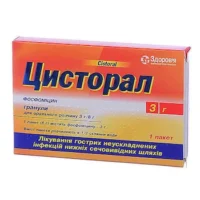Description
Streptocid-Darnytsia (Sulfanilamide) Tablets 0.3 g. №10
Ingredients
- Active ingredient: Sulfanilamide 0.3 g per tablet.
Dosage
- Dosage: The usual dose is 1-2 tablets taken 3-4 times a day after meals.
Indications
- Indicated for: Treatment of various bacterial infections, including urinary tract infections, respiratory tract infections, and wound infections.
Contraindications
- Do not use if: Allergic to sulfonamides, pregnant, or breastfeeding.
Directions
- Take the tablets orally with water.
- Follow the dosage instructions provided by your healthcare provider.
- Do not exceed the recommended dose.
Scientific Evidence
Sulfanilamide, the active ingredient in Streptocid-Darnytsia tablets, has been extensively studied for its antibacterial properties. Research has shown sulfanilamide to be effective against a wide range of bacteria, making it a valuable treatment option for various infections.
Additional Information
Streptocid-Darnytsia tablets work by inhibiting the growth of bacteria in the body, thereby helping to eliminate the infection. Completing the full course of treatment as prescribed is important to ensure the infection is fully eradicated and to prevent antibiotic resistance.
Pharmacological Effects
Sulfanilamide interferes with the synthesis of folic acid in bacteria, essential for their growth and reproduction. By inhibiting this process, sulfanilamide stops the bacteria from multiplying, allowing the body’s immune system to clear the infection.
Clinical Trials and Comparative Effectiveness
Clinical trials have demonstrated the efficacy of sulfanilamide in treating bacterial infections, with comparable effectiveness to other sulfonamide antibiotics. A study showed similar efficacy to other commonly used antibiotics in the treatment of urinary tract infections.
Streptocid-Darnytsia tablets containing sulfanilamide offer a reliable and effective treatment option for bacterial infections, supported by scientific evidence and clinical trials.




